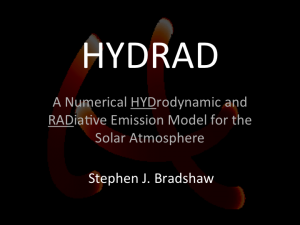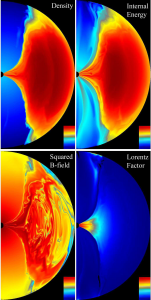New planets are now being discovered routinely around other stars with the Kepler mission recently detecting planets close to Earth-sized in the assumed habitable zones of their parent stars. The dramatic growth of exoplanet research in astronomy and its emphasis on discovering potentially habitable planets around other stars is a rich area for collaboration between the space physics and astronomy communities. Habitability is not viable around a magnetically active star without the protection of a substantial planetary magnetic field. Understanding the possible habitability of such planets, therefore, requires a deeper knowledge of how the stars and planets interact and, in particular, what role magnetic fields play in this interaction. This, in turn, requires a broad range of expertise encompassing stellar magnetism, stellar variability, exoplanet discovery and characterization, and, most importantly, space plasma physics. This proposal defines a targeted approach to exploring star-planet magnetic interactions utilizing our knowledge of the Sun’s interactions with the Earth, Saturn and Jupiter as calibration points and the expertise of the proposal team in modeling these systems. Capitalizing on the unique synergies within the Department of Physics and Astronomy at Rice, where we have leaders in the space physics, solar, and astronomy communities, and partnering with colleagues in Puerto Rico to bolster our radio astronomy and exoplanet expertise, provides a strong foundation from which to develop this relatively unique inter-disciplinary endeavor. Such an effort is well-suited to the goals of the INSPIRE program at the NSF: it attacks a problem of significance to a broad scientific community with the characterization and identification of possibly habitable exoplanets being endorsed by both the Astrophysics and Planetary Science Decadal Surveys while the better understanding of the Sun’s interaction with the planets of the solar system is a major component of the Space Physics Decadal survey. Furthermore, the proposed project is intrinsically inter-disciplinary, utilizing tools and science from a number of astronomy and space physics sub-disciplines. It also has a great potential for significant societal impact as it contributes to the search for life elsewhere in the galaxy.
NSF INSPIRE project: Modeling the Magnetic Interactions between Stars and Planets
September 14th, 2015 by toffoLSAP Presentation on Hydrad by Stephen Bradshaw
May 6th, 2015 by toffoLSAP Meeting Notes 3/30, 2015- Simulation Codes – Edison Liang
March 30th, 2015 by toffoEdison Liang – Codes
My group uses 3 different types of simulation codes to model relativistic plasma phenomena in high-energy astrophysics and intense laser-target interactions:
PIC Codes :
1. EPOCH (U. of Warwick-Ruhl, open-source version of PSC used at LLNL and Germany): 3D explicit, ok but not great for high-g. (Rice & LANL clusters)
2. ZOHAR (LLNL, detailed in classic book by Birdsall & Langdon): 2D explicit, excellent for high-g. (only on LLNL cluster).
3. ipic3d (KUL-Lapenta, still under development): 3D fully implicit, so for only for low-g regimes. (to be imported to Rice).
4. LSP (SAIC, commerical code, high license fee): 3D explicit. Has collisions and MHD options. (under negotiation for license).
5. PICiinGPU (German GPU code): 3D explicit (Rice and Georgia Tech GPU clusters, not sufficient memory for production).
6. NNS code (Noguchi-Nishimura-Sugiyama): 2D explicit includes radiation and rad. damping (Rice & LLNL clusters).
MHD codes
FLASH (U. of Chicago): 3D Eulerian, multi-physics includes radiation transport, nuclear physics, EOS, SR, laser coupling. 3T, kinetic ions … (Rice and LANL clusters).
HARM (U. of Illinois): 2D Eulerian, axi-symmetric polar grid only. multi-physics includes radiation, GR, 1T (Rice clusters).
ATHENA (Princeton): 3D Eulerian, multi-physics includes radiation, 3T, gravity, SR, shear box…(Rice clusters).
Hyades (Commerical code, license fee): 1D Lagrangian, multi-fluid, EOS, laser coupling, radiation, 3T….(Rice cluster).
MC codes:
1. GEANT4 (CERN): 3D. has all high-energy NPP processes. fixed background. lacks lower energy physics. (Rice clusters).
2. Rice-OU Radiation Code: 2D slab, sphere or cylinder grids only. Includes most astrophysics radiation processes. FP solvers for coupled particle distributions (Rice clusters).
3. MK Compton code: 1D slab, sphere or cylinder grid only. Time-independent. Fixed thermal or nonthermal electron distributions. Fast and simple: ideal for training beginning and undergrad students in MC.
MHD simulations of accretion onto black holes -Edison Liang
March 3rd, 2015 by toffoPanels from final timestep t = 8000 M (1.4×105 s) of HARM data, as labelled for different physical quantities. We show a cut-out in the r-z plane, with the black hole’s horizon shown on left. As detailed in the text, the radial direction is scaled logarithmically, and angular dimension is scaled more finely toward the equator. Therefore, the finest resolution is obtained closest to the horizon and equator. This causes a “spreading” effect in the images, as they are shown evenly spaced by cell number, not physical value. Each quantity is shown on a logarithmic scale, with dark red being the highest values, black being the lowest.A selection of movies demonstrating the advanced numerical modeling and visualization capabilities of the Solar Physics Group. The movies show the predicted evolution of an active region core subject to a large number of small-scale heating events (nanoflares), as it would be observed by the SDO/AIA 94, 131, 171, 193, 211, and 335 Å channels. There are 400 magnetic field lines comprising the active region core, which was subject to a total of 4000 nanoflares with energies drawn from a power-law distribution between 10^23 – 10^25 erg and a spectral index of -2.5. The delay between nanoflares re-energizing plasma along a field line was chosen to be proportional to the energy of the next event. These movies represent ‘synthetic’ observations and they can be analyzed using exactly the same tools and techniques as the real observations provided by our fleet of space-based instrumentation. This allows direct comparisons to be made between model results and observational data, and provides extremely strong constraints on the physics of coronal loops and on the properties of potential coronal heating mechanisms. Figure courtesy of Edison Liang.
Numerical modeling in Solar Physics – Stephen Bradshaw
February 24th, 2015 by toffoA selection of movies demonstrating the advanced numerical modeling and visualization capabilities of the Solar Physics Group. The movies show the predicted evolution of an active region core subject to a large number of small-scale heating events (nanoflares), as it would be observed by the SDO/AIA 94, 131, 171, 193, 211, and 335 Å channels. There are 400 magnetic field lines comprising the active region core, which was subject to a total of 4000 nanoflares with energies drawn from a power-law distribution between 10^23 – 10^25 erg and a spectral index of -2.5. The delay between nanoflares re-energizing plasma along a field line was chosen to be proportional to the energy of the next event. These represent ‘synthetic’ observations and they can be analyzed using exactly the same tools and techniques as the real observations provided by our fleet of space-based instrumentation. This allows direct comparisons to be made between model results and observational data, and provides extremely strong constraints on the physics of coronal loops and on the properties of potential coronal heating mechanisms.
About the Laboratory
January 5th, 2015 by toffoThe Department of Physics and Astronomy and the Rice Space Institute are pleased to announce the formation of the Laboratory for Space and Astrophysical Plasmas. LSAP will focus on bringing together and applying our understanding of plasma physics in the relatively well-observed solar system with increasingly sophisticated astronomical observations in order to explore common plasma-physical mechanisms. An important goal of the Laboratory will be to foster stronger links between space physics and astronomy/astrophysics members of the Department by identifying and developing joint areas of research. LSAP will seek to define viable projects and identify targets of opportunity for funding. RSI will serve as the home for LSAP by facilitating discussion and interaction and by developing and administering group proposals. It is anticipated that the combined expertise that constitutes LSAP will allow us to blaze a path into new and exciting areas in astrophysical plasma research. The founding members of LSAP comprise representatives from each of the Space/Astronomy groups: Stephen Bradshaw (Solar), Chris Johns-Krull (Astronomy), Edison Liang (Astrophysics) and Frank Toffoletto (Magnetosphere). Our initial efforts to identify research topics of common interest have already led to 3 proposals in the process of development (Keck, INSPIRE, and an REU). The Lab plans to have monthly meetings to discuss topics of mutual interest. Should you wish to be included, please contact Frank Toffoletto.




